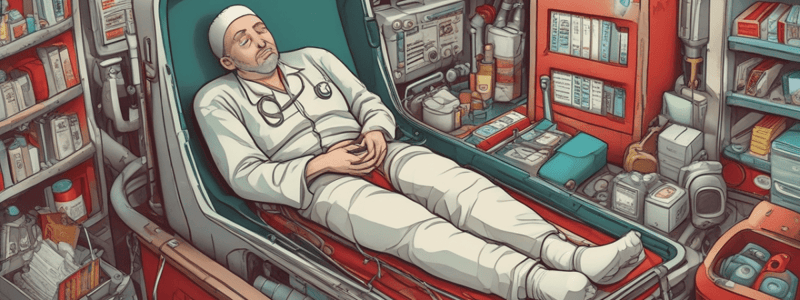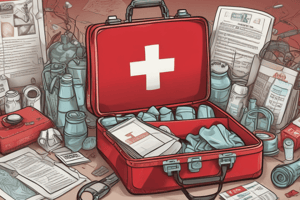Podcast
Questions and Answers
What does the 'S' in SAMPLE history stand for?
What does the 'S' in SAMPLE history stand for?
- Symptoms the casualty is experiencing (correct)
- Surgeries performed on the casualty
- Symptoms of the spouse
- Supplements taken by the casualty
What is the primary purpose of gathering a SAMPLE history?
What is the primary purpose of gathering a SAMPLE history?
- To diagnose the casualty's condition
- To determine the severity of the injury
- To provide medical history to healthcare professionals (correct)
- To administer medication
What is one of the vital signs to check on the casualty?
What is one of the vital signs to check on the casualty?
- Blood pressure
- Level of consciousness (correct)
- Body weight
- Pupil size
What does the acronym AVPU stand for?
What does the acronym AVPU stand for?
Who may be able to provide some of the SAMPLE history if the casualty is unable to respond?
Who may be able to provide some of the SAMPLE history if the casualty is unable to respond?
What is the key factor in determining how much mechanical energy an object has?
What is the key factor in determining how much mechanical energy an object has?
Which of the following symptoms would NOT require immediate medical attention?
Which of the following symptoms would NOT require immediate medical attention?
What is a key indicator of a potential medical emergency in an infant?
What is a key indicator of a potential medical emergency in an infant?
What is the body's normal reaction to physical and psychological events?
What is the body's normal reaction to physical and psychological events?
Which of the following is a sign of a potential medical problem in an adult?
Which of the following is a sign of a potential medical problem in an adult?
What type of infection is meningitis?
What type of infection is meningitis?
Which of the following diseases is caused by a virus and has no vaccine available to prevent it?
Which of the following diseases is caused by a virus and has no vaccine available to prevent it?
What is the best defence against HIV?
What is the best defence against HIV?
Which infection can cause severe liver damage and has a vaccine available to prevent it?
Which infection can cause severe liver damage and has a vaccine available to prevent it?
What is the primary concern when dealing with blood or body fluid exposure?
What is the primary concern when dealing with blood or body fluid exposure?
What can you observe in a casualty to identify signs of a potential medical problem?
What can you observe in a casualty to identify signs of a potential medical problem?
Why is it essential to call for medical help following first aid?
Why is it essential to call for medical help following first aid?
What is an example of a sign that can be felt during a head-to-toe exam?
What is an example of a sign that can be felt during a head-to-toe exam?
What is the importance of knowing the EMS telephone number in your community?
What is the importance of knowing the EMS telephone number in your community?
What can a casualty tell you about during a medical history assessment?
What can a casualty tell you about during a medical history assessment?
What is the user's responsibility when using this book?
What is the user's responsibility when using this book?
What should the user not do with medication according to St. John Ambulance?
What should the user not do with medication according to St. John Ambulance?
What is the condition for including symptom relief medication in workplace first aid kits?
What is the condition for including symptom relief medication in workplace first aid kits?
What does St. John Ambulance provide regarding the accuracy of the information?
What does St. John Ambulance provide regarding the accuracy of the information?
What is the user advised to do when providing first aid?
What is the user advised to do when providing first aid?
What is the primary purpose of the Medical Advisory Group?
What is the primary purpose of the Medical Advisory Group?
What is St. John Ambulance's charity work focused on?
What is St. John Ambulance's charity work focused on?
How many front-line volunteers does St. John Ambulance have across Canada?
How many front-line volunteers does St. John Ambulance have across Canada?
What supports St. John Ambulance's charitable work in Canada and around the world?
What supports St. John Ambulance's charitable work in Canada and around the world?
Since what year has St. John Ambulance been a leading authority in first aid and CPR services?
Since what year has St. John Ambulance been a leading authority in first aid and CPR services?
What is an indication of shock in a casualty?
What is an indication of shock in a casualty?
What is the primary purpose of the head-to-toe exam?
What is the primary purpose of the head-to-toe exam?
What should you do if you find an injury during the head-to-toe exam?
What should you do if you find an injury during the head-to-toe exam?
Why should you respect the casualty's modesty during the head-to-toe exam?
Why should you respect the casualty's modesty during the head-to-toe exam?
What should you check for during the head-to-toe exam of the head?
What should you check for during the head-to-toe exam of the head?
What should you do if the casualty is unconscious during the head-to-toe exam?
What should you do if the casualty is unconscious during the head-to-toe exam?
Why should you watch the casualty's face during the head-to-toe exam?
Why should you watch the casualty's face during the head-to-toe exam?
What should you do if you need to expose an area of the casualty's body during the head-to-toe exam?
What should you do if you need to expose an area of the casualty's body during the head-to-toe exam?
Why is it important to speak to the casualty throughout the head-to-toe exam?
Why is it important to speak to the casualty throughout the head-to-toe exam?
What should you note during the head-to-toe exam?
What should you note during the head-to-toe exam?
Flashcards
'S' in SAMPLE history
'S' in SAMPLE history
Symptoms the casualty is experiencing.
Purpose of SAMPLE history
Purpose of SAMPLE history
To provide medical history to healthcare professionals.
Vital sign to check
Vital sign to check
Level of consciousness.
Acronym AVPU
Acronym AVPU
Signup and view all the flashcards
SAMPLE history provider
SAMPLE history provider
Signup and view all the flashcards
Mechanical energy key factor
Mechanical energy key factor
Signup and view all the flashcards
Body's reaction to events
Body's reaction to events
Signup and view all the flashcards
Type of infection: meningitis
Type of infection: meningitis
Signup and view all the flashcards
Best defence against HIV
Best defence against HIV
Signup and view all the flashcards
Concern with body fluid exposure
Concern with body fluid exposure
Signup and view all the flashcards
Observing a casualty
Observing a casualty
Signup and view all the flashcards
Call for medical help
Call for medical help
Signup and view all the flashcards
Sign that can be felt
Sign that can be felt
Signup and view all the flashcards
EMS number importance
EMS number importance
Signup and view all the flashcards
Casualty tells you about
Casualty tells you about
Signup and view all the flashcards
User's responsibility
User's responsibility
Signup and view all the flashcards
Medication DON'T
Medication DON'T
Signup and view all the flashcards
Symptom relief medication condition
Symptom relief medication condition
Signup and view all the flashcards
St. John Ambulance provides
St. John Ambulance provides
Signup and view all the flashcards
User advised to do
User advised to do
Signup and view all the flashcards
Medical Advisory Group purpose
Medical Advisory Group purpose
Signup and view all the flashcards
St. John Ambulance's charity
St. John Ambulance's charity
Signup and view all the flashcards
SJA front-line volunteers
SJA front-line volunteers
Signup and view all the flashcards
SJA work support
SJA work support
Signup and view all the flashcards
SJA leading authority since
SJA leading authority since
Signup and view all the flashcards
Indication of shock
Indication of shock
Signup and view all the flashcards
Head-to-toe exam purpose
Head-to-toe exam purpose
Signup and view all the flashcards
Find injury during exam
Find injury during exam
Signup and view all the flashcards
Respect casualty's modesty
Respect casualty's modesty
Signup and view all the flashcards
Check during head exam
Check during head exam
Signup and view all the flashcards




